牛津上海版英语八年级下册教案全集
沪教牛津版八年级下册英语 Unit 2 1- Reading 教案
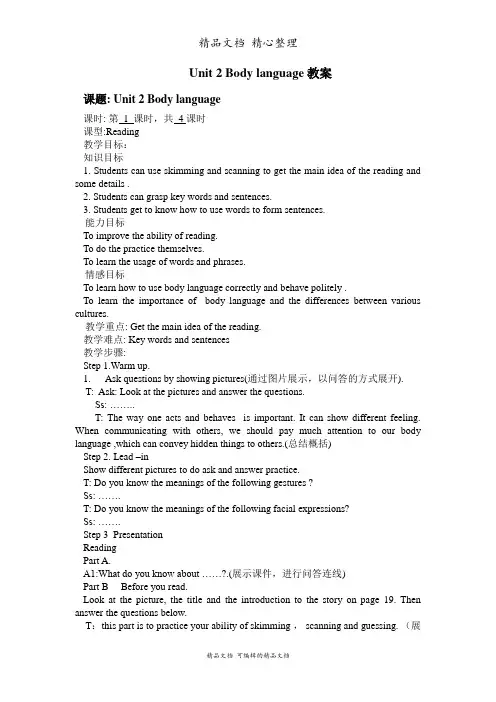
Unit 2 Body language教案课题: Unit 2 Body language课时: 第 1 课时,共 4 课时课型:Reading教学目标:知识目标1. Students can use skimming and scanning to get the main idea of the reading and some details .2. Students can grasp key words and sentences.3. Students get to know how to use words to form sentences.能力目标To improve the ability of reading.To do the practice themselves.To learn the usage of words and phrases.情感目标To learn how to use body language correctly and behave politely .To learn the importance of body language and the differences between various cultures.教学重点: Get the main idea of the reading.教学难点: Key words and sentences教学步骤:Step 1.Warm up.1.Ask questions by showing pictures(通过图片展示,以问答的方式展开).T: Ask: Look at the pictures and answer the questions.Ss: ……..T: The way one acts and behaves is important. It can show different feeling. When communicating with others, we should pay much attention to our body language ,which can convey hidden things to others.(总结概括)Step 2. Lead –inShow different pictures to do ask and answer practice.T: Do you know the meanings of the following gestures ?Ss: …….T: Do you know the meanings of the following facial expressions?Ss: …….Step 3 PresentationReadingPart A.A1:What do you know about ……?.(展示课件,进行问答连线)Part B Before you read.Look at the picture, the title and the introduction to the story on page 19. Then answer the questions below.T:this part is to practice your ability of skimming , scanning and guessing. (展示课件,提醒学生速读时把握关键点)Listen to the passage and answer the questionsT: Listen to the reading .(展示问题,利用Reading练习听力,一举两得)Part CV ocabularyC1 T:Let’s revise vocabulary and try to guess which words or phrases in the reading have similar meanings to the words below. .(展示课件并通过实例讲解做题的技巧,边提示边练习)C2: T:Complete their conversation with the words from the box.(展示课件,问答,提醒学生注意使用正确的形式)StrategyIdentifying the speaker(展示课件,利用Reading中的例句引导,并提醒学生注意标点符号)Part DComprehensionD1 Simon is talking to a friend on the phone. Read the story on P19 and complete his words with the information from the story.(展示课件,边问边答)D2 Read the story again and answer the questions below in complete sentences. T: D2 are mainly about how much you have learned about the reading. Let’s have a check.(利用课件进行问答)D3 Group workIn pairs ,discuss what your classmate’s body language is saying about him/her . Offer two questions to help them.And ask them to report y result to the whole class. Let’s see which group is the best! (让学生问题为话题,展开讨论。
)沪教牛津版初中英语八年级下册全套教学案
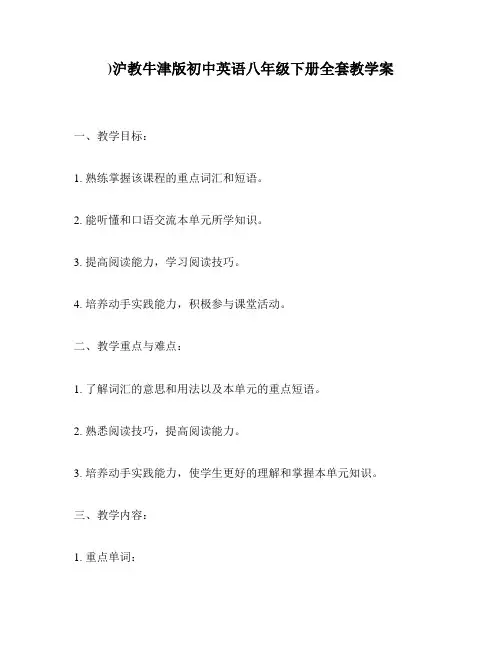
)沪教牛津版初中英语八年级下册全套教学案一、教学目标:1. 熟练掌握该课程的重点词汇和短语。
2. 能听懂和口语交流本单元所学知识。
3. 提高阅读能力,学习阅读技巧。
4. 培养动手实践能力,积极参与课堂活动。
二、教学重点与难点:1. 了解词汇的意思和用法以及本单元的重点短语。
2. 熟悉阅读技巧,提高阅读能力。
3. 培养动手实践能力,使学生更好的理解和掌握本单元知识。
三、教学内容:1. 重点单词:weight, health, rarely, regularly, profit, competition, instruction, presentation, energy, relaxed, nervous, fitness, concentrate, coordinate2. 重点短语:lose weight, give instructions, take part in, be relaxed, be nervous, energy drinks, figure out3. 阅读技巧:skimming and scanning4. 课堂活动:口语交际练习、听力练习、阅读理解练习、实践活动。
四、教学方法:1. 情境教学法2. 演示教学法3. 互动式教学法五、教学过程:1. 导入通过放一段视频或图片,引起学生的兴趣和好奇心,用自己的话简要描述其中的人或事。
2. 自主学习要求学生阅读或朗读本单元的课文,听音频或看视频,注意课文中的重点词汇和短语。
学生在自主学习的过程中,可以采用自己的方式,如读或背单词、模仿或演绎对话,或通过画画或电脑录制等形式来加深印象。
3. 互动探究根据所学内容进行互动探究,学生可以通过组合或匹配单词和短语来练习。
也可以进行角色扮演,让学生在实际情境中运用所学语言。
4. 实践活动通过实践活动的方式,让学生更加深入的了解所学单词和短语的应用场景。
如制作海报、口头介绍健康饮食、设计健身计划、动手制作健身用品等等。
牛津上海版八年级下册U5教案
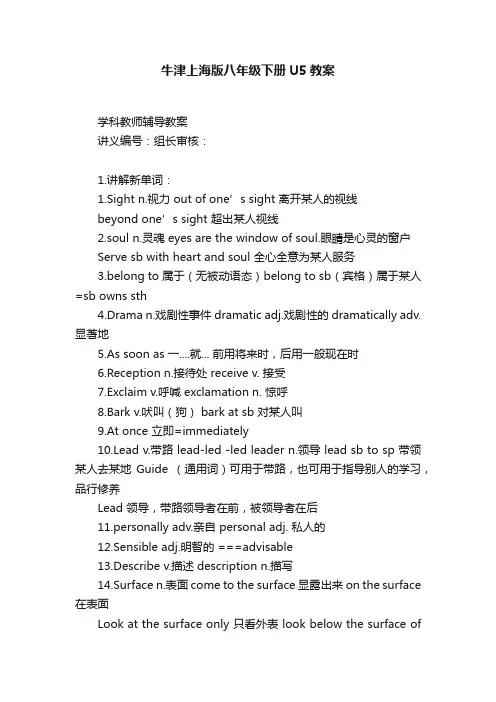
牛津上海版八年级下册U5教案学科教师辅导教案讲义编号:组长审核:1.讲解新单词:1.Sight n.视力out of one’s sight 离开某人的视线beyond one’s sight 超出某人视线2.soul n.灵魂 eyes are the window of soul.眼睛是心灵的窗户Serve sb with heart and soul 全心全意为某人服务3.belong to 属于(无被动语态)belong to sb(宾格)属于某人=sb owns sth4.Drama n.戏剧性事件 dramatic adj.戏剧性的 dramatically adv. 显著地5.As soon as 一....就... 前用将来时,后用一般现在时6.Reception n.接待处 receive v. 接受7.Exclaim v.呼喊 exclamation n. 惊呼8.Bark v.吠叫(狗) bark at sb 对某人叫9.At once 立即=immediately10.Lead v.带路 lead-led -led leader n.领导 lead sb to sp 带领某人去某地Guide (通用词)可用于带路,也可用于指导别人的学习,品行修养Lead 领导,带路领导者在前,被领导者在后11.personally adv.亲自 personal adj. 私人的12.Sensible adj.明智的 ===advisable13.Describe v.描述 description n.描写14.Surface n.表面 come to the surface 显露出来 on the surface 在表面Look at the surface only 只看外表 look below the surface ofthings 看到事物的本质15.Dead adj.运作的,也是die的过去分词,die-died-dead宾格代词用于替代处于宾语位置上的名词,可以用作直接宾语和间接宾语。
牛津上海版英语八年级下Unit4教学设计
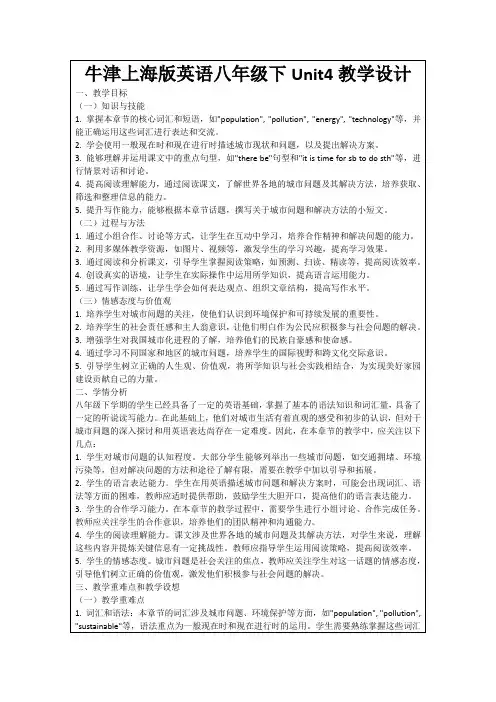
5.课后拓展:鼓励学生在课后收集有关城市问题的资料,如新闻报道、案例分析等,加深对城市问题的认识,提高自主学习能力。
6.评价方式:采用多元化的评价方式,如自评、互评、小组评价等,关注学生的全面发展,提高他们的学习积极性。
3.写作能力:学生需要学会如何围绕城市问题展开论述,表达自己的观点,并运用所学词汇和语法进行写作。
(二)教学设想
1.创设情境,激发兴趣:利用图片、视频等资源,呈现城市现状和问题,激发学生对本章节话题的兴趣,为后续教学做好铺垫。
2.分阶段教学,循序渐进:
a.词汇和语法教学:通过预习、课堂讲解、课后复习等环节,帮助学生掌握词汇和语法知识。课堂上,可采用游戏、竞赛等形式,增加学习的趣味性。
(四)课堂练习
1.完成课本上的练习题,巩固词汇、语法知识。
2.小组合作完成一篇关于城市问题及其解决方案的短文。
3.角色扮演:学生模拟成市长、环保专家等角色,针对某个城市问题进行讨论,并提出解决方案。
(五)总结归纳
1.教师引导学生回顾本节课所学内容,总结城市问题的原因、解决方案以及用英语表达的方法。
2.强调本节课的情感态度目标,让学生认识到环境保护和可持续发展的重要性。
牛津上海版英语八年级下Unit4教学设计
一、教学目标
(一)知识与技能
1.掌握本章节的核心词汇和短语,如"population", "pollution", "energy", "technology"等,并能正确运用这些词汇进行表达和交流。
2.学会使用一般现在时和现在进行时描述城市现状和问题,以及提出解决方案。
牛津上海版八年级下册 Unit 4 Newspapers 教学设计
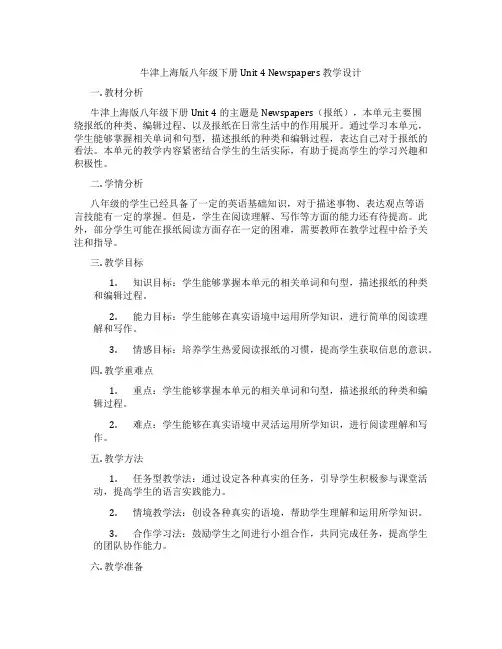
牛津上海版八年级下册 Unit 4 Newspapers 教学设计一. 教材分析牛津上海版八年级下册Unit 4的主题是Newspapers(报纸),本单元主要围绕报纸的种类、编辑过程、以及报纸在日常生活中的作用展开。
通过学习本单元,学生能够掌握相关单词和句型,描述报纸的种类和编辑过程,表达自己对于报纸的看法。
本单元的教学内容紧密结合学生的生活实际,有助于提高学生的学习兴趣和积极性。
二. 学情分析八年级的学生已经具备了一定的英语基础知识,对于描述事物、表达观点等语言技能有一定的掌握。
但是,学生在阅读理解、写作等方面的能力还有待提高。
此外,部分学生可能在报纸阅读方面存在一定的困难,需要教师在教学过程中给予关注和指导。
三. 教学目标1.知识目标:学生能够掌握本单元的相关单词和句型,描述报纸的种类和编辑过程。
2.能力目标:学生能够在真实语境中运用所学知识,进行简单的阅读理解和写作。
3.情感目标:培养学生热爱阅读报纸的习惯,提高学生获取信息的意识。
四. 教学重难点1.重点:学生能够掌握本单元的相关单词和句型,描述报纸的种类和编辑过程。
2.难点:学生能够在真实语境中灵活运用所学知识,进行阅读理解和写作。
五. 教学方法1.任务型教学法:通过设定各种真实的任务,引导学生积极参与课堂活动,提高学生的语言实践能力。
2.情境教学法:创设各种真实的语境,帮助学生理解和运用所学知识。
3.合作学习法:鼓励学生之间进行小组合作,共同完成任务,提高学生的团队协作能力。
六. 教学准备1.教师准备:提前准备好相关的教学材料,如课件、报纸、练习题等。
2.学生准备:学生提前预习课文,了解报纸的基本知识。
七. 教学过程1.导入(5分钟)教师通过提问方式引导学生谈论日常生活中接触到的报纸,激发学生的学习兴趣。
例如:“Do you like reading newspapers? What kind of newspapers do you usually read? Why?”2.呈现(10分钟)教师通过展示各种报纸的图片,引导学生说出报纸的种类,如政治、体育、娱乐等。
沪教牛津版本八年级下册英语unit1优质教案深圳

沪教牛津版本八年级下册英语unit1优质教案深圳一、教学内容本节课选自沪教牛津版本八年级下册英语Unit 1《Travelling》。
教学内容包括:Reading部分的“The journey to the West”以及相关词汇和语法。
二、教学目标1. 能够理解并运用本课的生词和短语,如:adventure, mountain, danger, excited等。
2. 能够运用一般过去时描述过去发生的事情。
3. 能够通过阅读文章,了解并复述《西游记》的主要情节。
三、教学难点与重点重点:一般过去时的运用,文章的理解与复述。
难点:一般过去时的正确使用,文章细节的理解。
四、教具与学具准备教具:PPT,黑板,教材。
学具:笔记本,文具。
五、教学过程1. 导入:通过展示一组旅游图片,引导学生谈论自己的旅游经历,引入本课主题。
2. 阅读前:让学生预测文章内容,激发他们的阅读兴趣。
3. 阅读中:引导学生阅读文章,完成相关练习,如填空、回答问题等,理解文章内容。
4. 阅读后:让学生复述文章,巩固所学知识。
a. 小组活动:学生分组讨论,运用一般过去时描述自己的旅游经历。
b. 例题讲解:针对一般过去时进行讲解,举例说明。
c. 随堂练习:让学生完成教材中的练习题,巩固语法知识。
六、板书设计1. 生词和短语:adventure, mountain, danger, excited等。
2. 一般过去时的结构:主语 + 动词过去式。
3. 《西游记》主要情节。
七、作业设计1. 作业题目:用一般过去时描述你最近一次的旅游经历。
答案示例:Last summer, I went to Beijing with my family. We visited the Forbidden City and climbed the Great Wall. We were all excited about the trip.2. 课后阅读:阅读教材中的其他文章,了解不同地方的旅游特色。
牛津上海版英语八年级下册英文教案全集
U1 Pollution FightersPeriod ITeaching objectives:1)Reviewing and learning some more information about trees.2) Having students catch the general ideas of the whole passage and understand some new words and expressions.e.g. living things, release, oxygen, etc.Difficulties:To read through the whole passage.Teaching aids:Blackboard, computer, over-head projectTeaching proceduresWarming-up:1) Write from the memory.2) Read the comics on page 15 and let students know that we’ll talk about the biggest and oldest living things on earth ----trees.Pre-task preparations:1)Let students talk freely to see how much they know about trees and makea guess to see whose number is close to the answer.2)Answer the questions in “ What do you know about …?”While-task procedures:1)Get students to look at the title, the subtitle, and the pictures to tell whoare pollution fighters.2)Let students read through the whole passage. Look at the statements on the screen and let them to find out the facts in the passage to complete the sentences.Post-task activity:1)According to what they’ve known, let them fill in the blanks to finish the sentences. Help students to summarize the general ideas of the passage. Assignments:Oral work: read the interview on page 17.Written work: preview the passage with the help of dictionary.Notes:Period IITeaching objectives:1)Learning the first part of the interview2)Having students review or learn the words and expressionse.g. be interested in, sip, etc.Language focus:1) Helping students pronounce new words correctly and try to memorize2) Doing some exercise to let students understand the language points. Difficulties:Use ‘noisy-noisily-noise, living-alive’ correctly to some of them.Teaching aids:Blackboard, computer, over-head projectTeaching proceduresWarming-up:Complete the statements to see how much they remember the information about trees.Pre-task preparations:Ask students the meanings of the new words. They can choose one of the answers. Then learn to read.While-task procedures:1) Review and introduce the words and expressions.2) Do some exercise to help students understand how to use the language points correctly.Post-task activity:Do some exercise by themselves.Assignments:Oral work: read the textWritten work: review the new words and expressions.Notes:默写时间太长以至于后面知识点来不及讲,减少学生做笔记时间,通过练习让学生理解知识点并且运用。
牛津上海版英语八年级下册英文教案全集
U1 Pollution FightersPeriod ITeaching objectives:1)Reviewing and learning some more information about trees.2) Having students catch the general ideas of the whole passage and understand some new words and expressions.e.g. living things, release, oxygen, etc.Difficulties:To read through the whole passage.Teaching aids:Blackboard, computer, over-head projectTeaching proceduresWarming-up:1) Write from the memory.2) Read the comics on page 15 and let students know that we’ll talk about the biggest and oldest living things on earth ----trees.Pre-task preparations:1)Let students talk freely to see how much they know about trees andmake a guess to see whose number is close to the answer.2)Answer the questions in “ What do you know about …?”While-task procedures:1)Get students to look at the title, the subtitle, and the pictures to tellwho are pollution fighters.2)Let students read through the whole passage. Look at the statements on the screen and let them to find out the facts in the passage to complete the sentences.Post-task activity:1)According to what they’ve known, let them fill in the blanks to finish the sentences. Help students to summarize the general ideas of the passage. Assignments:Oral work: read the interview on page 17.Written work: preview the passage with the help of dictionary.Notes:Period IITeaching objectives:1)Learning the first part of the interview2)Having students review or learn the words and expressionse.g. be interested in, sip, etc.Language focus:1) H elping students pronounce new words correctly and try to memorize2) Doing some exercise to let students understand the language points. Difficulties:Use ‘noisy-noisily-noise, living-alive’ correctly to some of them. Teaching aids:Blackboard, computer, over-head projectTeaching proceduresWarming-up:Complete the statements to see how much they remember the information about trees.Pre-task preparations:Ask students the meanings of the new words. They can choose one of the answers. Then learn to read.While-task procedures:1) Review and introduce the words and expressions.2) Do some exercise to help students understand how to use the language points correctly.Post-task activity:Do some exercise by themselves.Assignments:Oral work: read the textWritten work: review the new words and expressions.Notes:默写时间太长以至于后面知识点来不及讲,减少学生做笔记时间,通过练习让学生理解知识点并且运用。
沪教牛津版八年级下册英语 Unit 8 1- Reading 教案
Unit 8 Life in the future 教案课题:Unit 8 --- Life in the future课时:第 1 课时,共 4 课时课型:Reading教学目标:1. Let students know the related information about the Internet posts about life in the future.2. Students can know how to use related expressions to describe life in the future.3. Develop the reading ability by designing a post to describe the life in the future.4. The students can use the expressions and the useful sentence structures freely.教学重点:1. How to make the ss get interested in the content of the text.2. Let students know how to use the words and expressions to talk about daily life in the future.3. The students can use the expressions and the useful sentence structures freely. 教学难点:1. To master some usages of some useful expressions and develop an ability of how to get a further understanding of the text.2. Know how to use the important phrases and expressions to make a sentence.教学准备:PPT, Blackboard教学步骤:I. Pre-reading Presentation1. Freely talk: what do you know about….?Show some questions to them to discuss: what will life be like in the future? Hotel: houses: cars: communication…….2. Culture corner: At the 2010 Shanghai Expo, countries around the world displayed their dreamsof future cities. Learn some information about what life will be like in the future.3. Work in groups, Talk about the sentences about the future and the present. And discuss the following questions about what life will be like in the future?4. Tell them they are going to read an article about Life in the future. Introduce some new words before their reading. The teacher helps the students when they have trouble in reading the new words and ask group work to remember the new words II. While-reading Procedure1)Fast reading: Ss try to read the first sentence of each paragraph in the article on page 51 and have Ss try to tick (√) the descriptions that match the pictures.2) Detail reading: Read the article and find out the correct answers to Exercise C1.3) Read the article and write the correct answers to complete the sentences to Exercise C2.4) Learn the useful expressions in the passage:5) Read the article again and finish Exercise D1and D2.III. Post-task ActivityMore practice: Be more familiar with the whole passage and try to retell the story by using the new words and phrases.IV. Homework。
牛津上海版英语八年级下册《Unit 4 Newspapers》教学设计5
牛津上海版英语八年级下册《Unit 4 Newspapers》教学设计5一. 教材分析《Unit 4 Newspapers》是牛津上海版英语八年级下册的一单元,主要讲述了报纸的相关知识。
通过本单元的学习,学生能够掌握关于报纸的词汇和表达方式,了解报纸的种类、版面设计以及阅读报纸的好处等。
教材中包含了丰富的图片、阅读材料和实践活动,有助于激发学生的学习兴趣,提高他们的英语素养。
二. 学情分析八年级的学生已经具备了一定的英语基础,对于日常生活中的话题有一定的了解。
但部分学生对英语学习的兴趣不高,缺乏积极性。
针对这一情况,教师应充分调动学生的积极性,激发他们的学习兴趣,让他们在轻松愉快的氛围中学习英语。
三. 教学目标1.知识目标:学生能够掌握关于报纸的词汇和表达方式,了解报纸的种类、版面设计以及阅读报纸的好处等。
2.能力目标:学生能够运用所学知识,进行简单的英语交流和写作。
3.情感目标:培养学生热爱阅读报纸的良好习惯,提高他们的信息素养。
四. 教学重难点1.重点:报纸的词汇和表达方式,阅读报纸的技巧。
2.难点:如何运用所学知识进行实际交流和写作。
五. 教学方法1.任务型教学法:通过设定各种真实的任务,让学生在完成任务的过程中运用所学知识,提高他们的实际运用能力。
2.情境教学法:创设各种真实的语境,让学生在特定的语境中学习英语,提高他们的语言素养。
3.合作学习法:鼓励学生分组合作,进行讨论和交流,培养他们的团队精神和沟通能力。
六. 教学准备1.准备相关报纸的图片、文章和视频等教学资源。
2.设计各种任务和活动,以便在课堂上进行实践操作。
3.准备黑板、多媒体设备等教学工具。
七. 教学过程1.导入(5分钟)利用图片、视频等资源,引导学生谈论关于报纸的话题,激发学生的学习兴趣。
2.呈现(10分钟)展示报纸的种类、版面设计等,让学生了解报纸的基本知识。
同时,教授相关词汇和表达方式。
3.操练(15分钟)设计各种任务,让学生在实践中运用所学知识。
- 1、下载文档前请自行甄别文档内容的完整性,平台不提供额外的编辑、内容补充、找答案等附加服务。
- 2、"仅部分预览"的文档,不可在线预览部分如存在完整性等问题,可反馈申请退款(可完整预览的文档不适用该条件!)。
- 3、如文档侵犯您的权益,请联系客服反馈,我们会尽快为您处理(人工客服工作时间:9:00-18:30)。
8B Unit 1 Trees1. pollute (v.) pollution (n.)*Pollution has become one of the most serious problems of today’s society.*The factories aren’t allowed to let out dirty water for it may pollute the river.*Trees are thought as pollution fighters.2. f ight(v. n.)争斗,斗争` fight (against) sb / sthfighter (n.) 斗士3. scientist (n.)科学家science ( n.)科学4. collect (v.)收集collection (n.) 收藏品*He used to collect stamps when he was a young boy.*The dustmen collect the rubbish once a day.*My father usually collects me after school5. She is interviewing Doctor Ray.interview (v. n) interviewer (n.) interviewee (n.) trainer---trainee. / emplover----employee6. interest*He is telling a story to the children which interests them a lot.*Tom takes great interest in stamps collection.interested (a.) *be interested in +n./doing sth7 .live (v.) 生活直播的(a.) a live football matchalive (adj.) living (adj.) lively (adj.) life (n..) *When the boy was found at last .he was still alive.*We must leart a living language not adead one.*The young are usually lively and active.8. on the earth = in the world 当earth作为地球时. 前加“the”space前不加“the”9. good. 文中为n. 用处= use*I am only telling you this for your own good.*What good is it repainting if you are thinking of moving?10. make…. + adj. make us healthy / make it lighter.make…. + n.. We all made Mary our monitor.班长make….+ do sth . make me finish it in an hour.11. else 通常位于疑问词what/ where/ who等或nothing/ nobody/ no one/ something/ anything 等不定代词之后*What else did he say?*Do you want anything else, sir? -----Thanks nothing else.12.woods (n..) a piece of wood woods =forestwooden (a..) a wooden table13. in the end = finally =at last at the end of +time /place14.1) suppose (that) + a sentence*Scientists suppose that large dinosaurs lived in swamps .2)breathe (v. )呼吸be out of breath 气喘吁吁take a deep breath 做一次深呼吸15. thank (sb.)…for+n./doing sth*Thank for your help*Thank you for lending me your notebookthankful (a.) 感激的be thankful to sb. for sth.16. produce(v.)production (n.) 生产过程the production of carsproduct (n.) 产品well-made products cost more 制作精美的产品比一般贵17. enough oxygen/time/money…enough + n. (+to do …) adj. +enough (+to do…)18 .keep sb/sth +adj. 保持…处于某种状态keep the door openI’m sorry to keep you waiting for so longkeep sb/sth +doing 让..一直做某事19. Trees not only clean the air but also cool it.Trees cool the air and clean it as well.20. natural (a.) nature (n.) naturally (adv. )21. know / learn /eat a lot . a lot 跟v .后22. begin (v .) begin to do ….= begin doing …beginning (n .) at the beginning of …在。
开始23. warn (v .)warn sb. of sth. warn sb. (not) to do sth. warn (not) doing *The teacher warned the boys of the deep waiter.*She warned her husband of the danger of driving so fast.*The policeman warned the boy not to play football in the streets.warning (n .) It happened without any warning.24. protect….from / against.1) You should put on more clothes to protect yourself against /from cold.2) Sun glasses many protect your eyes from the sun.protection (n .) protective (a .)*You may improve your spoken English by talking with the native speakers.25. chemical ( a . n . ) 化学的,化学物质chemistry ( n . ) 化学a chemistry teacher . a chemical change.do chemistry homework dangerous chemicals.26. communicate (v .) 交流communicate….with communication (n .) 交流*Being deaf makes communication difficult. deaf 聋子* We should communicate with our parents if we meet some problems.27. one another ≈each other28. be in danger (n .) ( be out of danger ) dangerous ( a .)29. replace (re –do sth again ) rebuild . repaint/ replay/ rewrite/ review/ repeat30.destroy 彻底毁灭,很难恢复。
damage 价值降低,或外表破损,有修复可能*The heavy rain destroyed our hope of a panic.*The heavy rain damaged a lot of houses in this area.*The town destroyed by the war.8B Unit 2daily adv. 每天(every day)例如:·want to study English well, so I have to practise it daily.我想学好英语,因此我必须每天练习。
daily adj. 每日的;日常的n. 日报例如:·here are great changes in their daily lives. 他们的日常生活有巨大的变化。
increase v. (使)增加例如:·The wheat production increased a great deal this year. 今年的小麦产量大幅度增加。
·We have increased the price of paper. 我们提高了纸张的价格。
【反义词】:decrease v. 减少例如:·The population in Germany decreased last year. 去年德国的人口减少了。
impatient adj. 不耐烦的例如:·She is becoming impatient. 她变得着急起来。
【同根词】:patient; impatient; patience1.patient adj. 有耐心的, 例如:·She is so kind and always patient with those naughty children.她对这些淘气的孩子们是如此的和蔼,有耐心。
2.impatient adj. angry at having to wait 不耐烦的,急躁的,例如:·As a nursery teacher, you mustn’t be impatient with the children.作为幼儿园教师,你不该对孩子急躁。
